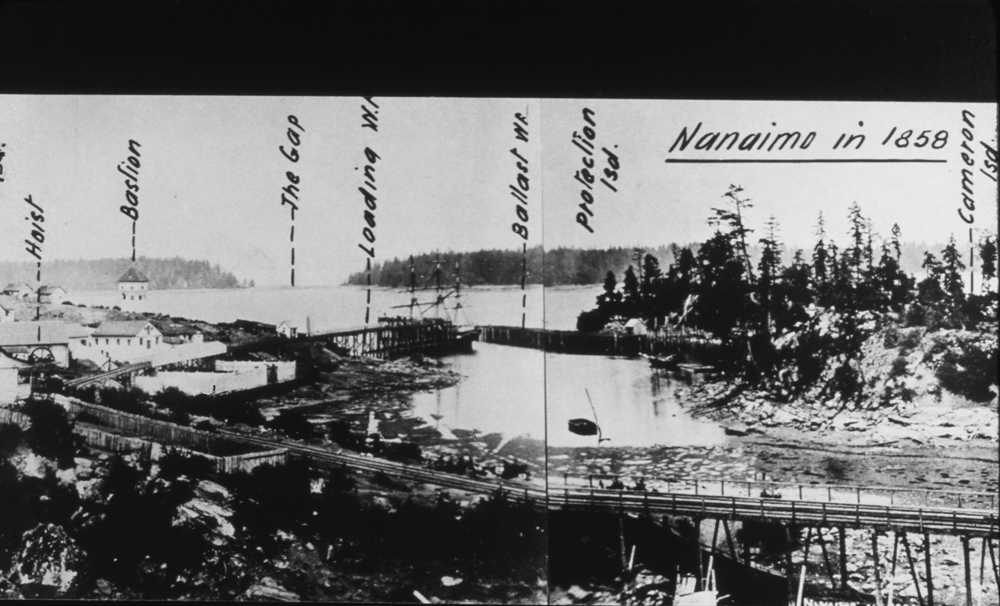Nanaimo Coal Mines
This map illustrates Nanaimo and area coal mines discussed in the Coal Tyee History Project VIUSpace collection. The collection consists of digitized audio recordings with transcripts of interviews conducted between 1979 and 1984 with Vancouver Island miners and their families. Selecting a mine from the map will provide a summary, along with links and quotes to the interviews (in the above collection) where the mine is discussed. Thank you to Katharine Rollwagen’s 2016 History 340 (Public History) class for providing the details for many of the mine summaries.
The interviews were conducted by Myrtle Bergren, William Barraclough, Bernard McNicholl, Lynne Bowen, Barbara Graves, Barrie Hardcastle, Joy Leach, Dale Lovick, Shirley Ramsay, and Ruth Tickle.
See Interview / Mine Distribution to see which mines are discussed the most in the interviews
 Nanaimo, 1858
Nanaimo, 1858
As the story goes, coal in Nanaimo was first brought to the attention of the Hudson’s Bay Company in 1849 by Snuneymuxw Chief Che-which-i-kan, whom was thereafter dubbed "Coal Tyee." After the black rocks brought to Victoria in 1850 were investigated, HBC clerk Joseph McKay was dispatched to Nanaimo to further explore the area known as Wenthuysen Inlet. McKay found what was to become known as the Douglas seam, and a post was established at Nanaimo harbour, with the intention of, in the words of Governor James Douglas, "tak[ing] possession of the coal beds lately discovered there for and in behalf of the Hudson’s Bay Company." By 1852, the first shipment of Nanaimo coal was loaded aboard the Cadboro, and Nanaimo’s presence as a coal mining centre on the Pacific coast had been established.
In November of 1854, the barque Princess Royal arrived with 24 coal miners and their families, and the community of Colviletown (named not after the coal discovery, but after Andrew Colvile, a former governor of the HBC) became more firmly established. It was renamed Nanaimo in 1860, and by 1874 had 1,000 residents. The HBC coal mining operation eventually evolved into a separate organization called the Nanaimo Coal Company, and in 1862, the operation was sold altogether to a British firm, the Vancouver Coal Mining and Land Company.
In 1869, an independent miner named Robert Dunsmuir discovered the Wellington seam near Diver Lake. Dunsmuir formed Dunsmuir, Diggle & Company and developed the very profitable Wellington Colliery, which was soon a worthy rival to the Vancouver Coal Mining and Land Company. Dunsmuir's company continued to grow and expand, with non-family interests slowly being bought out one by one, until in 1883, only Robert and his two sons James and Alexander remained as controlling partners. The company was renamed R. Dunsmuir & Sons.
With his economic and political influence on Vancouver Island, Robert Dunsmuir was able to secure the contract to build a railway between Nanaimo and Victoria. In return he received a $750,000 subsidy plus a huge land grant, including the mineral rights in, on, or under the lands. The E&N Land Grant comprised of approximately one fifth of Vancouver Island, and included a significant portion of First Nations territory. In order to finance the cost of building the railway, Dunsmuir's Esquimalt & Nanaimo Railway Company sold off large tracts of land, privatizing a large portion of the traditional territory of Hul'qumi'num peoples. Controversary tied back to the land grant on Vancouver Island is still ongoing today.
Dunsmuir & Sons continued to grow as a coal company on Vancouver Island, with operations (either mining or shipping) expanding to Extension, Ladysmith, Cumberland, and Union Bay. Robert Dunsmuir died in 1889, but son James had been increasingly responsible for running the business since his father's foray into Vancouver Island politics. The E&N Railway was sold in 1905 to the Canadian Pacific Railway, and in 1910, James Dunsmuir sold the coal mining interests to Canadian Collieries (Dunsmuir) Ltd. CCD continued to operate the coal mines in Nanaimo, eventually becoming Nanaimo's primary coal company when it took over the Western Fuel Company (the 1903 successor to the Vancouver Coal Mining and Land Company) in 1928.
Nanaimo's longest running and highest producing mine, the Esplanade No.1, closed in 1938. Coal continued to be mined in the local area, especially south of Nanaimo, until the Bright Mine closed in 1953. This marked the end of over 100 years of coal mining in Nanaimo.
For more information on coal mining in Nanaimo, and on the sites themselves see List of coal mines and landmarks in the Nanaimo area